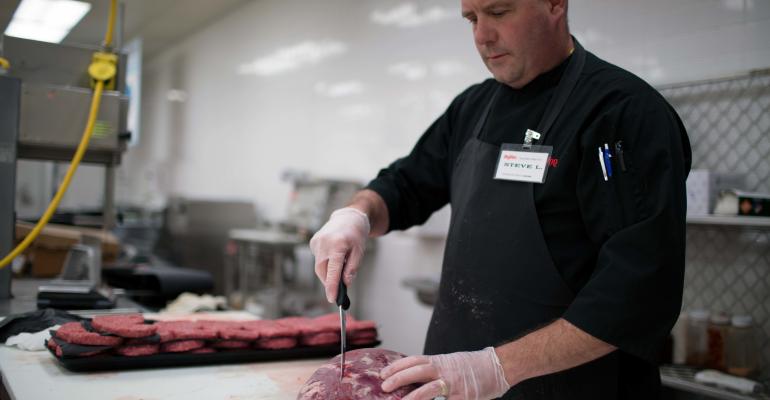Ground meats are adding life to a lethargic meat sector.
While the fresh meat aisle had volume sales of $13.77 billion for the 52 weeks ending July 16, down 1.1% vs. the year-earlier period, grind activity is rising in most meat categories and outpacing the categories’ overall sales rates, reports Circana, a Chicago-based market research firm.
Sales of chicken grinds grew 12.1% over the last year compared to an overall category increase of 0.5%. In addition, ground pork volume sales grew 3.1%, with an overall category decline of 1.7%; and ground beef was up 0.1% with a category decrease of 1.0%. While volume sales of ground turkey were down 4.7%, the decrease still is less than the 5.8% category decline.
Ground lamb, meanwhile, had perhaps the most significant growth, with volumes up 9.2% vs. a category sales decrease of 6.9%.
Circana research reveals that supermarkets are likely to increase ground meat activity by situating the various grinds together in the refrigerated case. That includes top-selling beef, pork, chicken, and turkey along with smaller revenue drivers, including ground veal, lamb, and bison, said Chris DuBois, Circana executive vice president of the protein practice.
Ground meats are attractive to many shoppers because they can serve as an ingredient in a wide range of recipes and generate various taste experiences, he said. “Pork, chicken, and turkey all have different textures and flavors,” DuBois said.
The sharp increase in at-home meal preparation sparked by the COVID-19 pandemic also is fueling shopper interest in grinds and leading to more joint ground meat sections in meat department cases, said Rick Stein, vice president of fresh foods for Arlington, Va.-based FMI — the Food Industry Association.
Such sections often range from 6 to 9 feet and contain an array of ground proteins and products with a variety of attributes, such as being all-natural, grass fed, and developed from animals without the use of antibiotics, he said.
“It makes sense to have all the grind sets together because supermarkets are doing so much business with them,” Stein said. “It used to be that ground beef and pork were situated adjacent to the beef and pork sections, but consumers like seeing all the selections together.”
Yet, despite the popularity of grinds, which consumers are using in a plethora of items, including spaghetti sauce, hamburgers, meat loaf, tacos, salads, chili, soup, pizza, baked ziti, enchiladas, lasagna, and casseroles, it is vital that operators also offer a host of other meat alternatives to reach a wider shopper base, he said. That includes providing traditional cuts in different sizes and thicknesses along with relevant meal suggestions, Stein said.
“Consumers are starved for ideas on what to prepare and how,” he said, adding that supermarkets can differentiate their operations by enabling meat department clerks and butchers to interact with shoppers and provide preparation advice. “Having strong customer service in the meat department adds to the shoppers’ perception of value,” Stein said.
Making the fresh meat area more inviting to consumers is crucial if operators are to keep attracting and maintaining customers, said Anne-Marie Roerink, principal and founder of 210 Analytics LLC, a San Antonio-based market research and marketing strategies firm and author of the Power of Meat 2023 report, published by FMI and the Washington, D.C.-based Foundation for Meat and Poultry Research and Education.
That includes combatting the perception of meat as a higher-priced protein option by featuring selections in the weekly circulars and utilizing social media to spotlight promotional items, she said. “Shoppers are chasing deals and it’s worrisome to see that total store trips are up, but meat trips are down,” Roerink said. “Ensuring that promotional activity is seen by primary and secondary shoppers alike is important.”
Incorporating messages on shelf dividers, signage, and labels in the self-service area also is an effective way to influence the many younger shoppers who are avoiding the more costly full-service case, she said.
Supermarkets can further appeal to cost-conscious shoppers and “attack inflation” by training meat cutters to package products with “the end price point in mind,” said Russell Zwanka, director of the food marketing program and associate professor — food marketing, at Western Michigan University in Kalamazoo. That includes ensuring that packages of red meat are available at a variety of prices, including under $10, between $10-$15, and $15 and up, he said.
“It’s the most impactful thing supermarkets can do to help customers during these times,” Zwanka said. “Retailers previously lowered the price per pound and then made the packs as large as possible. But with the price per pound so much higher today, even a discounted product is going to be inordinately expensive when packaged in a larger ‘family size’ or ‘value pack.’”
Merchandising meats in smaller packages also is critical for meeting the needs of the large base of one- and two-person households, DuBois said, noting that many of those shoppers are seeking economically priced packages while reducing the chance of waste.
“Having limited and expensive selections takes people out of the meat case,” he said. “The next big opportunity for supermarkets is to figure out how to serve the smaller households, who often visit food service to get good cuts of meat.”
In addition, retailers can spotlight the less-expensive steaks from the chuck and round to promote the availability of meats for lower-cost meals, said Laura Hinton, senior director of B2B engagement and supply chain at the Centennial, Colo.-based National Cattlemen’s Beef Association.
“Chuck and round cuts often perform best with a marinade or when cooked slowly in liquid, and that gives retailers another opportunity to spread meal inspiration,” she said, noting that operators can highlight such options through social media, e-mail, and in-store via product tastings and point-of-sale materials.





